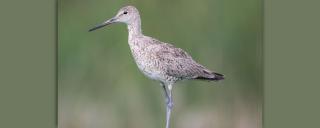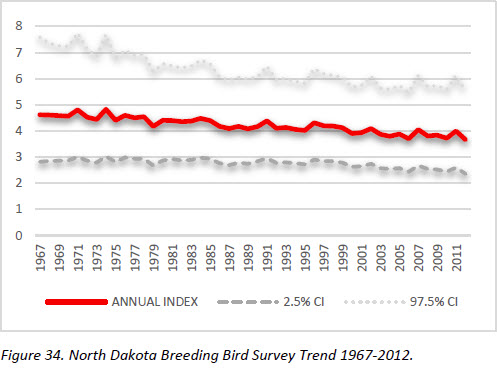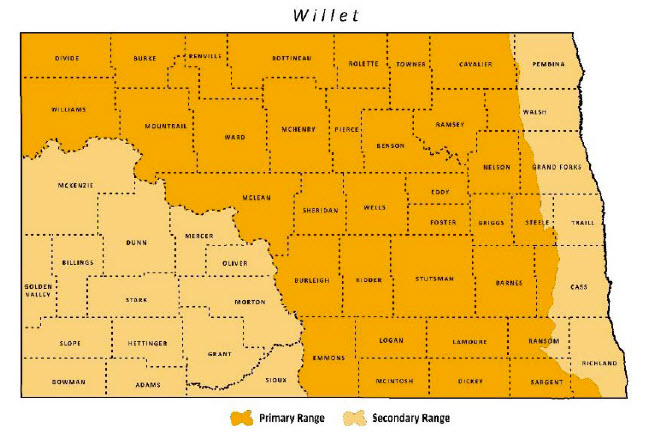
Willet
| Scientific Name | Tringa semipalmatus |
|---|---|
| General Description | L 15”, WS 26”, 8 oz. Gray overall except for striking black and white wings obvious in flight. |
| Status | Occurs in North Dakota from mid-April to September. Peak breeding season occurs from late May to mid-July. |
| Abundance | Fairly common. |
| Primary Habitat | Variety of wetlands associated with upland native grassland. |
| Federal Status | Migratory Bird. |
| Reason for Designation | Nearly 50% of this species population, which is showing a moderate decline regionally and nationally, breeds in the Prairie Pothole Region. It has been removed from the USFWS Birds of Conservation Concern list, but the species shows a slight population decline. Watch List species in need of Management Attention in Shorebirds of Conservation Concern 2015. |
Locations and Conditions of Key Habitat
Preferred Habitat
Large expanses of short, sparse grasslands, particularly native grassland, are important for nesting and foraging. Prefer idle grassland during nesting, and to a lesser extent grazed pasture, compared to other land uses such as hayland and cropland. Adults with broods will use taller, denser grass. A variety of wetland complexes of ephemeral, temporary, seasonal, semi-permanent, permanent wetlands, and intermittent streams used for foraging. Avoid wetlands with dense, emergent vegetation, and prefer shallow-water areas with sparse shoreline vegetation. Nests are located in short grass. Mean territory size is 44.3 ha. Primary foods include insects, small crustaceans, mollusks, and occasionally small fish.
Key Areas and Conditions for Willet in North Dakota
No specific sites have been identified. Densities appear highest in central North Dakota although they are fairly common throughout the Missouri Coteau and Drift Prairie.
Problems Which May Affect this Species
Habitat
Conversion of grassland to cropland, energy development and urban expansion. Degradation of grasslands from invasive plants, woody encroachment, succession, and loss of diversity. Specifically, the loss of native prairie and associated wetlands is the greatest threat to Willets in North Dakota. Over-grazed pastures which are grazed season-long are less attractive to Willets.
Other Natural or Manmade Factors
Insecticides may decrease food availability. Vehicle and power line collisions are one cause of direct mortality. Early mowing can destroy nests or kill the adult on the nest. Nest predation is a key mortality factor.
Research and Survey Efforts
Current Research or Surveys
- Since 2004, the USFWS HAPET staff has coordinated a breeding shorebird survey in the Prairie Pothole Region of North and South Dakota. Surveys are conducted twice to correspond with the shorebird breeding season. Five grassland breeding shorebird species are targeted, including Willet. Results from these surveys help guide grassland and conservation efforts.
Previous Research or Surveys
- Ducks Unlimited (ND SWG T2-2-R) determined wetland occupancy by shorebirds in wind energy developments in the Prairie Pothole Region of North Dakota. The project was initiated in 2009 and a final report provided in 2011. Results indicate wind energy was probably not causing substantial reduction in shorebird occupancy, including Willet. However, apparent presence of shorebirds was low and potential effects of wind development on shorebird populations needs further research and monitoring (Walker and Gleason 2011, Niemuth et al. 2013).
- Delta Waterfowl (ND SWG T-13-R) determined shorebird nest success and nest-site selection in northeast North Dakota. The project was initiated in 2005 and a final report provided in 2007. Vegetation surrounding shorebird nests was relatively short, sparse, native grass species. Shorebirds avoided sites dominated by invasive plants (e.g. leafy spurge, Canada thistle, Kentucky bluegrass, smooth brome, stinging nettle, and wormwood.) Habitat has a stronger impact on shorebird nest success than predator removal (Wiens 2007).
- Ducks Unlimited (ND SWG T-3-1 and T-8-R) determined demographic performance of prairie-nesting shorebirds in North Dakota. The project was initiated in 2004 and a final report provided in 2007. The highest reproductive success for shorebirds was in those areas with high amounts of grassland, low levels of edge between cropland and grassland, and high amount of wetland area. Preserving large intact grassland/wetland landscapes are key to safeguarding populations of Willet (Stephens and Walker 2007).
Additional Research or Surveys Needed
Demographic information, including fled
Population and Trend Estimates

- North American Population Estimate 2012: 160,000
- North Dakota BBS Trend: see figure 34
- Survey-wide BBS Trend 1966-2012: -0.50
Management Recommendations
- Provide a diversity of wetlands of varying types and salinity.
- Protect large tracts of native prairie.
- Burning, mowing, and grazing removes litter accumulation and provide shorter, sparser vegetation preferred by Willets.
- Use rotational grazing, delay grazing until late May/early June.
Monitoring Plans
The Breeding Bird Survey continues to be a useful monitoring tool, however the annual surveys implemented by HAPET in 2004 are valuable. Ensuring all BBS routes are conducted annually is priority. A shorebird monitoring plan should follow The International Shorebird Survey (ISS) Program for Regional and International Shorebird Monitoring (PRISM) and “Guidance for Developing and Implementing Effective Shorebird Surveys.”
2005-2015 Progress
The Willet was reassigned from a Level I to a Level II Species of Conservation Priority due to stable to slightly declining population trends. Several State Wildlife Grant Projects (T2-9-R, T2-11-HM, T-18-R, T-21-D, T-22-HM, T-23-HM, T-25-HM, T-27-HM, T-37-D) have contributed to habitat enhancement of wetlands and grasslands for Willet and other wetland/grassland dependent birds.

Note: A listing of works consulted when compiling the information on this page may be found in the 2015 State Wildlife Action Plan.
